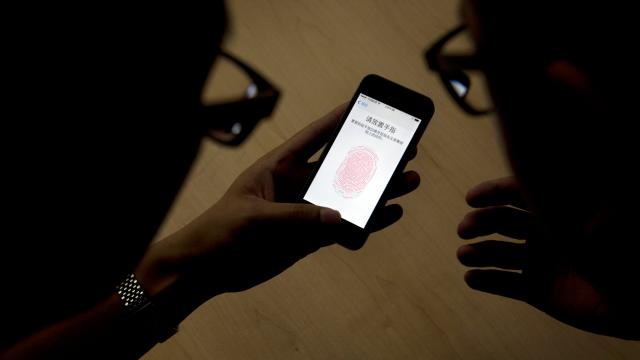Could future iPhones come with a built-in panic button to discreetly summon the cops? It’s certainly a possibility, judging by Apple’s recent patent filings.
Photo: AP
According to a patent granted to Apple on Tuesday for “Biometric Initiated Communication”, the panic button could operate from a number of inputs including “a particular finger or finger sequence”, “a particular timing or cadence”, or whether input was “entered with a particular force”.
One possible application of the button is “to call emergency services without that fact being known to an assailant or other aggressive person that prompted the emergency call”, and potentially send GPS data and/or streaming audio or video to the authorities. It could also be used to execute a wipe of any crucial data on the phone, such as social security numbers.
It’s certainly a feature that at face value sounds suitably pro-safety. But whether or not a mobile phone panic button ends up being much more than security theatre — something designed to provide the reassuring illusion of safety instead of actual safety — may end up relying on a lot of factors that can’t be engineered into a phone.
A panic button by definition can only be as effective as the response it summons; while it may offer a new way to summon the cops, your mileage may vary depending on who those cops are. A 2008 US Bureau of Justice Statistics survey concluded that just 28.3 per cent of three violent crimes (robbery, aggravated assault and simple assault) were responded to within five minutes, another third was responded to within six to 10 minutes and the rest much longer, at 11 minutes to an hour. Just one third of property crimes were responded to within 10 minutes.
But individual police departments can do much worse, like in Baltimore, where in certain neighbourhoods a domestic violence call could take an average of 18 minutes to reach an officer. According to the Economist, police in New Orleans took an average of 20 minutes to reach priority calls in 2015, while at one point Detroit police were taking close to an hour to respond to “priority” calls.
It’s tough to imagine surreptitious panic button calls — especially in situations where the user might not be able to talk directly with a dispatcher — would do much better. A good comparison might be home security systems.
The New York Times estimated some 36 million security systems around the US in 2010, which is much less than the number of estimated iPhones. Those stationary security systems are already a low police response priority, due in part to a high rate of false alarms. (In 2011, the Detroit Police Department decided only to respond to burglar alarms after they were verified by the security company.) The problem of false alarms and where and how to direct police resources won’t be made easier by putting panic buttons in millions of phones, especially when considering recent research has found mobile phone butt dials might already constitute a huge percentage of calls to emergency services.
There’s also the continued problem of police shootings in the US, in which vague or incomplete information about suspects can play a contributing role.
But Apple is far from the first to come up with the idea of equipping phones with some kind of panic button.
Earlier this month, the Mexican city of Juarez released the “No estoy sola” (“I am not alone”) app, which dispatches text messages to emergency contacts with a link to the location of the user. Another app developed by Kenyan university student Edwin Inganji had similar functionality, but also relayed information to authorities.
In India, which last year rolled out a plan to equip all new phones with panic buttons and GPS by 2018, the New York Times noted some advocates fighting the country’s epidemic of sexual assault were optimistic while others cautioned it wouldn’t solve deep-rooted problems with the responsiveness and professionalism of police forces in India.
[CNBC]
